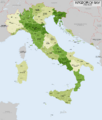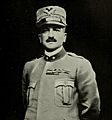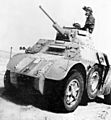Kingdom of Italy (1861–1946) facts for kids
Quick facts for kids
Kingdom of Italy
|
|
|---|---|
| 1861–1946 | |

Kingdom of Italy in 1936
|
|
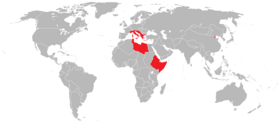
Maximum extent of the Italian Empire
|
|
| Capital | |
| Religion | Roman Catholicism Protestantism Judaism |
| Government |
|
| King | |
|
• 1861–1878
|
Victor Emmanuel II |
|
• 1878–1900
|
Umberto I |
|
• 1900–1946
|
Victor Emmanuel III |
| Prime Minister | |
|
• 1861
|
Count of Cavour (first) |
|
• 1922–1943
|
Benito Mussolini (Il Duce from 1925) |
|
• 1945–1946
|
Alcide De Gasperi (last) |
| Legislature | Parliament |
| Senate | |
| Chamber of Deputies | |
| History | |
| 17 March 1861 | |
|
• March on Rome
|
31 October 1922 |
|
• Fall of the Fascist regime
|
25 July 1943 |
|
• Republic established
|
2 June 1946 |
| ISO 3166 code | IT |
The Kingdom of Italy was a country that existed from 1861 to 1946. It began when King Victor Emmanuel II of Sardinia was declared the first King of Italy. The kingdom ended in 1946. After a public vote, Italians decided to become a republic, which is the modern country of Italy today. This kingdom was formed during the Italian unification, a time when different parts of Italy came together.
Contents
How Italy Became a Kingdom
Italy declared war on Austria in 1866. It was allied with Prussia. After their victory, Italy gained the region of Veneto. In 1870, Italian troops entered Rome. This event ended the Pope's rule over a large area, which had lasted for over a thousand years.
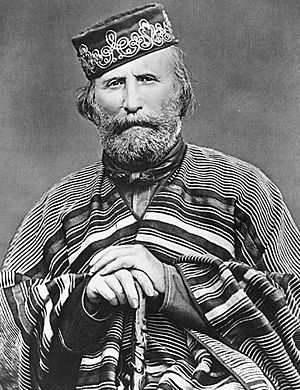
Italy's Role in World Wars
Forming Alliances Before World War I
In 1882, Italy joined the Triple Alliance with Germany and Austria-Hungary. This happened because Italy had disagreements with France over colonial expansion. Even though Italy became good friends with Germany, its alliance with Austria-Hungary was not very strong. Italy wanted to gain control of Trentino and Trieste. These areas were part of Austria-Hungary but had many Italian-speaking people.
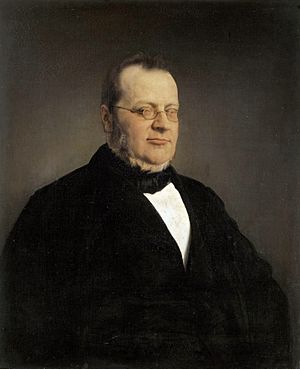
Italy in World War I
Because of these reasons, Italy decided to join the Allied Powers in 1915. Britain had invited Italy, promising more land from Austria-Hungary if they joined the war. This offer was better than what Austria-Hungary had offered for Italy to stay neutral. After the war, Italy won a permanent seat in the Council of the League of Nations. This was an important international organization.
The Rise of Fascism
The period from 1922 to 1943 is known as "Fascist Italy." During this time, the National Fascist Party governed the country. Benito Mussolini was their leader. The Fascists took strong control and did not allow people to disagree. They also worked to improve the economy and supported traditional social values. They even improved relations with the Roman Catholic Church.
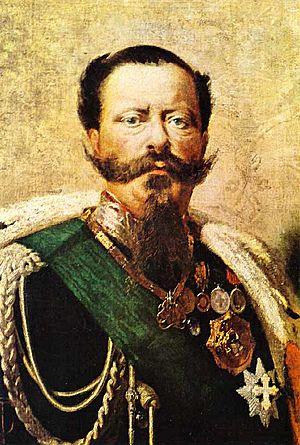
Italy in World War II
Italy was a major member of the Axis powers in World War II. They fought on several fronts and had some early successes. However, after defeats in Africa and the Soviet Union, and when the Allied forces landed in Sicily, things changed. King Victor Emmanuel III had Mussolini arrested. The Fascist Party was then shut down in areas controlled by the Allies. In September 1943, the new government signed an armistice (a peace agreement).
German forces quickly occupied northern Italy. They were helped by Fascist loyalists. They set up the Italian Social Republic, which was a puppet state still led by Mussolini. This led to a civil war in Italy. The Italian Co-belligerent Army and the resistance movement fought against the Social Republic's forces and their German allies.
The End of the Kingdom
After World War II, Italy faced big problems. Its economy was ruined, society was divided, and many people were angry at the monarchy for supporting the Fascist government for twenty years.
Soon after the war and the country's liberation, people were unhappy with the monarchy. This led to a public vote on whether Italy should remain a monarchy or become a republic. Italians chose to end the monarchy and form the Italian Republic. This is the country we know today.
Even after unification, Italian society was often divided. People were separated by class, language, and region. The difference between the North and South of Italy is still noticeable today.
Images for kids
-
Italian unification between 1815 and 1870
-
Count Camillo Benso of Cavour, the first Prime Minister of the unified Italy
-
Victor Emmanuel II, the first King of the united Italy
-
Crown of the Kingdom of Italy
-
A factory machinery exposition in Turin, set in 1898, during the period of early industrialization, National Exhibition of Turin, 1898
-
A 1899 FIAT advertisement
-
Galleria Vittorio Emanuele II in Milano was an architectural work created by Giuseppe Mengoni between 1865 and 1877 and named after the first King of Italy, Victor Emmanuel II.
-
The Triple Alliance in 1913, shown in red
-
Francesco Crispi promoted the Italian colonialism in Africa in the late 19th century.
-
Italian mounted infantry in China during the Boxer Rebellion in 1900
-
Giovanni Giolitti was Prime Minister of Italy five times between 1892 and 1921.
-
Italy and its colonial possessions at the time of the outbreak of World War I: the area between British Egypt and the firmly held Italian territories is the region of southern Cyrenaica which was under dispute of ownership between Italy and the United Kingdom.
-
Gabriele D'Annunzio, national poet (vate) of Italy and a prominent nationalist revolutionary who was a supporter of Italy joining action in World War I
-
Generalissimo Luigi Cadorna (the man to the left of two officers to whom he is speaking) while visiting British batteries during World War I
-
Members of the Arditi corps in 1918. More than 650,000 Italian soldiers lost their lives on the battlefields of World War I.
-
Armando Diaz, Chief of Staff of the Italian Army since November 1917, halted the Austro-Hungarian advance along the Piave River and launched counter-offensives which led to a decisive victory on the Italian Front. He is celebrated as one of the greatest generals of World War I.
-
Italian Prime Minister Vittorio Emanuele Orlando (2nd from left) at the World War I peace negotiations in Versailles with David Lloyd George, Georges Clemenceau and Woodrow Wilson (from left)
-
Residents of Fiume cheering D'Annunzio and his Legionari in September 1919, when Fiume had 22,488 (62% of the population) Italians in a total population of 35,839 inhabitants
-
Benito Mussolini (second from left) and his Fascist Blackshirts in 1920
-
Erwin Rommel meeting Italian General Italo Gariboldi in Tripoli, February 1941
-
The Italian Army in Russia fought on the Eastern Front.
-
Three men executed by public hanging in a street of Rimini, 1944
-
Members of the Italian resistance in Ossola, 1944
-
Umberto II, the last king of Italy
See also
 In Spanish: Reino de Italia (1861-1946) para niños
In Spanish: Reino de Italia (1861-1946) para niños




